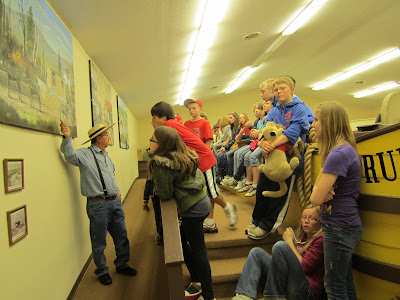
Well, after some delicious honey I'm ready to tell you more about my visit to Green Mount Cemetery.

The grave that is visited most often is that of John Wilkes Booth. What's interesting is that his grave is actually unmarked. His family has a large family lot that contains John's parents, several siblings, and his grandfather. John's name appears on the back of the large monument in the center of the lot.

Visitors often leave pennies on the monument to mark their visit. I noticed that the pennies are always left "heads up". Why do you think that is?

Two other men that conspired with John Wilkes Booth are also buried at Green Mount. They are Samuel Arnold and Michael O'Laughlin. Arnold was the second to the last of the conspirators to pass away. His headstone is just a small stone about the size of a brick that simply says "Arnold".

O'Laughlin died in prison after coming down with Yellow Fever in 1867. Dr. Samuel Mudd worked hard to save his life, but his efforts were in vain. The large monument on this grave is a family monument. I wonder what kind of financial background Michael came from.

I learned that there are sixteen Civil War generals buried at Green Mount. I'm sure that you have heard of General Joseph E. Johnston. Johnston was a Confederate soldier. When his friend, Union General William T. Sherman died, Johnston served as a pallbearer at his funeral; during the procession in New York City in 1891, he kept his hat off as a sign of respect in the cold, rainy weather. Someone had some concern for the old general's health and asked him to put on his hat, to which Johnston replied "If I were in his place and he standing here in mine, he would not put on his hat." He caught pneumonia and died several weeks later.

This is the grave of General Isaac Trimble. Trimble was one of the three division commanders in Pickett's Charge at the Battle of Gettysburg. Trimble was shot in the left leg which would require amputation. He was captured by Union forces and held as a prisoner for the duration of the War.

This large building is a public mausoleum. It stands on the location of a previous mausoleum. Green Mount's staff was recently able to confirm that the original mausoleum was used to hold the bodies of three of the four Union soldiers killed at the Pratt Street Massacre in 1861. This was the first instance of the Civil War where deaths occurred. The bodies were held in the mausoleum for about a week before being shipped home to Massachusetts.

This is the grave of Matilda O'Neill Wood. As a teenage girl she became a heroine during the War of 1812 when the British attacked Havre De Grace, MD. The British had captured her father after he fought valiantly to defend his town. After learning of her father's capture, Matilda rowed herself out to meet with the British Admiral in an effort to secure her father’s release. Her efforts proved successful and her father escaped the hangman’s noose.

I really enjoyed my visit to Green Mount! I learned that cemeteries are an amazing place to learn about history. In addition to many veterans of the Civil War, Green Mount is also the final resting place for soldiers that fought in the Revolutionary War and the War of 1812. I'd encourage you to stop by and visit Green Mount for yourself if you're ever in Baltimore!





















